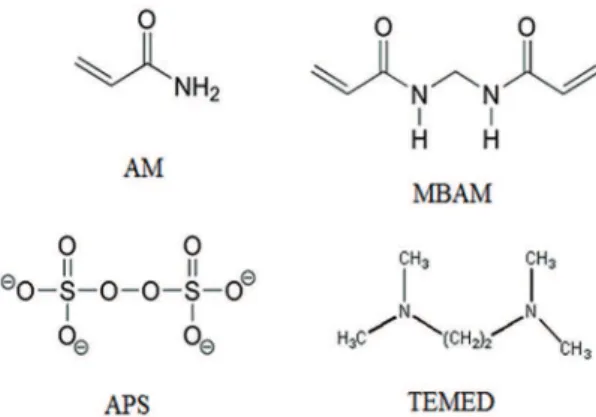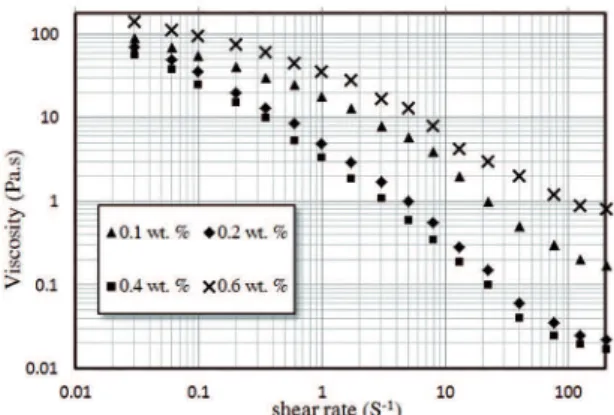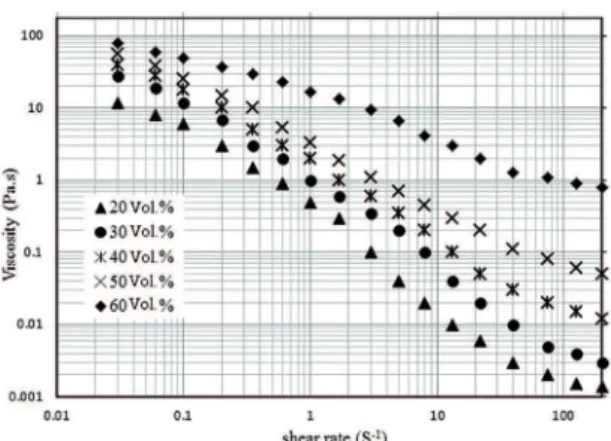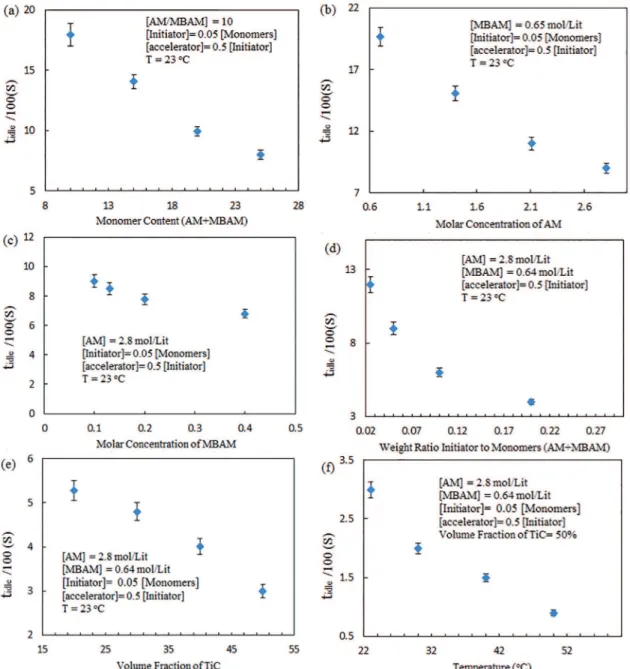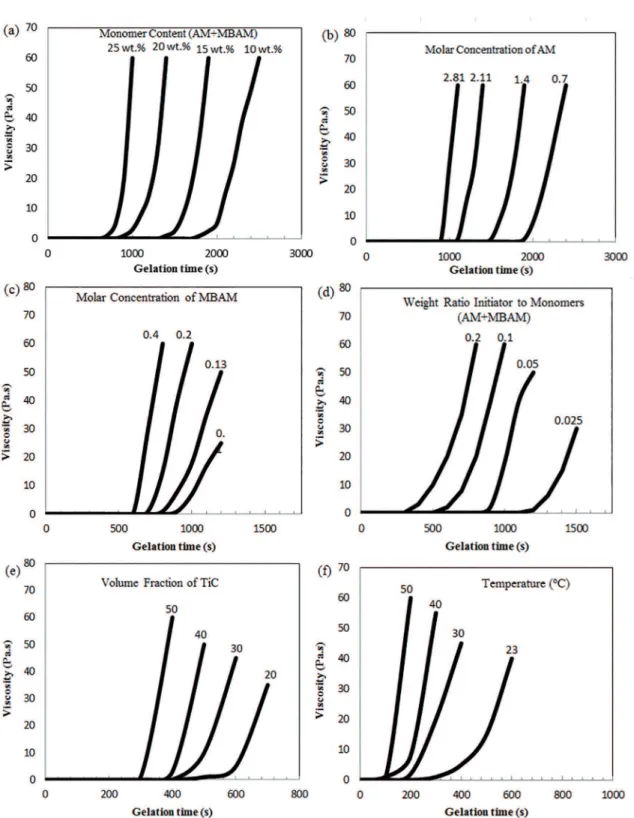Chemo-Rheological Behavior of Aqueous Titanium Carbide Suspension and Evaluation of
the Gelcasted Green Body Properties
Hamze Foratirada*, Hamid Reza Baharvandib, Mohammad Ghanadi Maragheha
Received: May 30, 2016; Revised: October 17, 2016; Accepted: November 21, 2016
Gel-casting is an advanced colloidal processing method for fabricating ceramic green parts. In this
project acrylamide-based monomers were used as a gelcasting system. The efects of tetramethylammonium
hydroxide and polyethylenimine dispersants on the premix solution containing titanium carbide powder
have been studied via observation of the zeta potential and rheological behavior. The efect of various parameters on the gelation time and viscosity of solution and lexural strength and the shrinkage rate
of titanium carbide green body were investigated. The results presented that the order of dispersion capacity of the tetramethylammonium hydroxide dispersant was better than the polyethylenimine dispersants. The results showed that the gelation time decreased and viscosity increased with increasing the monomer content, solid loading, initiator amount and temperature. The highest bending strength (39 MPa) was obtained for the samples containing 25 wt.% monomer content and 50% solid loading.
Keywords: Gel-casting, Titanium Carbide, Rheological Behavior
* e-mail: hforatirad@aeoi.org.ir
1. Introduction
Titanium carbide with the excellent mechanical and thermal properties at elevated temperature has been widely used for high temperature applications1-6. It has high modulus, hardness
and strength and excellent wear and oxidation resistance.
Also, it has low coeicient of thermal expansion and high thermal conductivity. However, it is diicult to produce
ceramic bodies with complex shapes and accurate dimensions by the conventional forming techniques. For many of these applications, the gelcasting process is extensively used7-9.
Gelcasting is a near-net-shape ceramic forming method
with high green body strength, which was irst developed at Oak Ridge National Laboratory by Omatete and Janney
during the 1990s10. In gelcasting, a concentrated ceramic
slurry is created by mixing a ceramic powder and a monomer solution. After this, the ceramic suspension is poured into a mold to get the desired shape, then removed from the mold
and inally dried. The principle of the gelcasting process is
based on the in-situ polymerization of an organic monomer
solution which forms a 3-dimensional macromolecular network
that holds powders together10. In order to produce ceramic
products with good performance, dimensional stability and
high green strength, a luid ceramic slurry with low viscosity
and with as high solid loading as possible is required. High solid loading increases the viscosity and on the other side,
reduces the shrinkage. The optimal conditions can be obtained
if an appropriate dispersant concentration is used11.
The most important process step in slurry processing
for production of ceramics which can signiicantly improve the inal properties of bodies, is obtaining a homogenous structure with low shrinkage rate and high green strength.
It is an imperative to have slurry with good dispersion and a desirable rheological behavior, because the quality of dispersion controls the casting behavior and the resulting green-body properties. However, the parameters which can
inluence the physical properties of the ceramic green body (e.g., gelation time, shrinkage, and strength of green body)
are monomer composition, monomer content, monomers ratio, the amounts of initiator and catalyst additives, solid loading, temperature and dispersant.
Although a number of studies have investigated the preparation of TiC ceramics by gelcasting12,13, few investigations
have been carried out into the inluences of the gelcasting
parameters on the rheological behavior and properties of the green body. In this paper, the gelcasting of titanium carbide is studied and optimized in terms of dispersant type, dispersant concentration, monomer content, monomer ratio, initiator and catalyst amounts, solid loading and temperature.
2. Experimental
The starting ceramic powder used in this experiment with an average particle size of 3-5 µm was a commercial
high-purity titanium carbide (Paciic Particulate Materials (PPM) Ltd, Canada) with the speciic surface area 2.2 m2/g
and 0.11% retained free carbon. Aqueous gelcasting was processed using acrylamide (AM, C2H3CONH2, Sigma-a Nuclear Fuel Cycle Research School, Nuclear Science and Technology Research Institute, Tehran,
Tehran Province, Iran
b Department of Materials Science and Engineering, Malek-Ashtar University of Technology – MUT,
Aldrich) as a monomer, N,N´-methylenebisacrylamide (MBAM, (C2H3CONH2)2CH2, Sigma-Aldrich) as a
cross-linker, N,N,N´,N´-tetramethylethylenediamine (TEMED,
(CH3)2NCH2CH2N(CH3)2) as a catalyst and ammonium persulphate [APS, (NH4)2S2O8] as an initiator (both from Sigma–Aldrich Co., US). Figure 1 shows the molecular structures of monomer system components. In order to compare the various dispersants, Tetramethylammonium hydroxide (TMAH, C4H13NO, Merck Co.) and Polyethylene imine (PEI, (C2H5N)n, Merck Co.) were used as the dispersants. The quantity of dispersants applied with respect to the previous studies14,
were selected at the 0.4 and 2wt% of the ceramic powder,
respectively. The gelcasting low chart presented in Figure 2 shows the process of producing the inal products from the
titanium carbide powder. The slurries were degassed for 10 min after casting in the mold. The slurry was degassed for another 10 min when the initiator and catalyst were added. After the monomers had polymerized, the green bodies were demolded. After gelcasting, the samples were dried in a commercial oven, at 60 oC with relative humidity of 70% for 60 h.
At irst, the inluence of various dispersants and solids
loading on the zeta potential and rheological behavior of TiC suspension was investigated. And then, various monomer pre-mix solutions, with different monomer contents, monomers ratio and initiator contents were prepared and the gelation behavior of these systems in the presence or
absence of ceramic powder and at diferent temperatures was
investigated and compared with each other. Gelation was initiated immediately after adding predetermined amounts of initiator and accelerator.
The surface chemical properties of as-received powders was determined using by FTIR spectroscopy (Spectrum one,
Perkin-Elmer, Wellesley, MA) after mixing with KBr powder.
Z-potential measurements were performed by an acoustic
and electroacoustic spectrometer (DT-1200, Dispersion
Technology Inc., Bedford Hills, NY). The zeta potentials were recorded as a function of the pH of the suspension. The titration was automatically performed by means of a built-in autotitrator using 0.1M HCl and 1M NaOH solutions. The shear viscosity and the time dependency of pre-mix solutions and viscosities during gelation were measured by a Visco 88 viscometer with a concentric-cylinder having a
diameter of 30 mm. Steady state shear low curves were
measured in a shear rate range between 0.03 and 200 S-1. A
digital thermometer (i.e. pH-mV-temperature meter with an accuracy of 0.1 oC, Lutron TM-905, Taiwan), was used to
measure the temperature of pre-mix solutions and suspensions during the progress of gelation. The bending strength of the
dried samples were determined by a three-point lexure test
in accordance with ASTM C1161 with Universal Testing
Machine (ZWICK, Z050) at 0.5 mm/min loading rate. The
fracture surfaces morphologies of the fabricated porous ceramics were investigated by scanning electron microscopy
(SEM V18 ZISS).
3. Result and discussion
The TiC powder surface layer composition was determined by FT-IR spectroscopies analyze. Figure 3 shows the FT-IR
spectrum of the as-received TiC powder. The peak centered at
466 cm-1 can be attributed to the Ti-C vibration. The band
at 611 cm-1 and 1450 cm-1 are due to titanium oxide and
assigned to the lattice vibrations of TiO2.The peak centered at 1012 cm-1 can be attributed to characteristic O-O stretching
vibration. The absorption band at 1639 cm-1 is due to the
bending vibration of coordinated H2O as well as Ti–OH. The absorption of hydroxyl groups was created the broad
peaks at 3450 cm-1. The FT-IR results indicated the presence
of TiO2 on the surface of the received powders. Therefore, it could be concluded that the surface properties of TiC powders were largely determined by the TiO2 composition on their surface15.
Zeta potential of TiC powders in the absence of any dispersant in deionized water is shown in Figure 4. The Figure 1: The molecular structures of monomer system components.
and thus zeta potential values decrease gradually. The results
show that the TMAH and PEI dispersants can increase the
stability of suspensions. However, the TMAH dispersant
provides good dispersion compared with the PEI dispersant18.
Figure 5 shows the efect of dispersant concentrations
on the viscosity of premix solutions containing 50 vol. % TiC, 20 wt. % monomers content (AM + MBAM) and the ratio AM/MBAM of 10, as a function of shear rate at the
pH = 9. In any concentration, the low curve deviates from a
Newtonian behavior or shear thinning behavior. This behavior is characterized by the decrease in viscosity at increasing shear rates19. It is obvious that the viscosity of the slurry
decreases with an increase in the dispersant dosage. It is worth mentioning that an optimum concentration of the dispersant is 0.4 wt. %. The viscosity of slurries increases suddenly as the concentration of the dispersant increases to 0.6 wt. %.
Additional dispersant ions cause the compressive efect on the electrical double layer (EDL) and so, the thickness of
the charge cloud on the surface of titanium carbide particles decreases, thereby decreasing the repulsive forces and suspension stability18,19.
Figure 3: FT-IR spectra of as-received TiC powders in the wavenumber range of 4000–400 cm−1.
Figure 4: Zeta potential of TiC suspention without dispersant and TiC in the premix solution with and without dispersant.
isoelectric point (IEP) of TiC powders is at pH 3.1. The TiO2
surface oxide in the presence of water easily hydrolysed to
Ti-OH groups. When the pH is lower than the IEP, Ti–OH
reacts with H+ leaving Ti–OH+
2 with positive zeta potentials.
When the pH is higher than the IEP, Ti–OH reacts with
OH-, yielding Ti–O- with negative zeta potentials16. Zeta
potential of TiC powders in the presence of the monomer (premix solution), was decreased compared to TiC suspension without dispersant. It suggests that the uncharged monomer molecules screen the charge developed at the solid/liquid interface and decrease the stability of suspension17. TMAH
dispersant dissociates to (CH3)4N+ and OH- in the presence
of water18 and Hydroxyl group promotes the production
Ti-O- inducing more negative charge on the TiC surface.
The IEP of TiC suspension disappeared with 2 wt. % PEI
addition (Figure 4) and a highly positive surface charge
was achieved at the low pH. PEI is a cationic polymer
with repeating unit composed of the amine group and two carbon aliphatic CH2CH2 spacers. When an amino group is protonated, it will be attracted to the negatively charged Ti-O- surfaces group. The protonation of the amine groups
in PEI molecules and subsequent expansion of the polyions
due to the mutual charge repulsion are responsible for highly positive zeta potential in the wide pH range (positive zeta potential with a value of 30 to 44 mV was obtained in the pH
range 5 to 10). In the high pH range (pH > 10), PEI actually
carries no charge and the polymers exist as free molecules
Figure 5: The efect of dispersant concentrations on the viscosity
of premix solutions containing 50 vol. % TiC.
Figure 6 shows the rheological properties of the TiC
suspensions vs. diferent solids loading at the 0.4 wt. %
dispersant. It can be seen from the curves that the suspensions in all of the solid loading show shear thinning behavior and
belong to pseudoplastic luid. It also can be found from the
curves that the viscosity of suspension increases with the solid loading again. In the solid loading below the 50 vol. %, suspension viscosities are lower than 1 Pa.s and to be enough to provide the required stability to the slurry. There is a substantial increase in the viscosity, when solid loading reaches 60 vol. %. The viscosity increases to > 1 Pa.s at shear rate of 75 s-1, which is not suitable for the gelcasting process19.
Figure 7 shows the fracture surface of the resulted green body (20 wt. % monomers content, 50 vol. % solid loading and 0.4 wt. % dispersant) with a compact and homogeneous distribution appearance and a limited number of pores. As seen
Figure 6: Variation of viscosity with the solid loading in the 0.4
wt. % TMAH dispersant at diferent shear rates.
Figure 7: SEM micrograph of fracture surface of TiC green body
gelcasted with 0.4 wt. % dispersant.
dispersed and also the grains are connected by 3D polymeric networks which are responsible for the strength of the green
body. The limited number of the holes in the sample can also be caused by the air caption in the gelcasting process.
The idle time, tidle, i.e. the time between the addition of the initiator and the catalyst and the beginning of polymerization that is equivalent to the time available for
casting the slurry. Idle time is afected by several factors such as monomer concentration, monomer to cross-linker
ratio, initiator concentration, amount of solid loading and solution temperature20-22. Figures 8 and 9 show the
changes in the tidle and viscosity of the pre-mix solution as the function of monomer content, molar concentration of AM, molar concentration of MBAM, weight ratio initiator to monomers (AM+MBAM), volume fraction of TiC and temperature, respectively. As shown in Figure 8a, idle time decreases with the increase of monomer. Also, as seen in Figure 9a, viscosity increases relatively slow during a certain period and then increases rapidly with increasing monomer content. The higher the concentration of the monomer, the faster polymerization. It is due to an increase in the polymer
chain length and formation of intermolecular crosslinking
through more crosslinking sites at intense concentrations of
the polymer. Hence, the polymerization rate increases, which decreases the gelation time. In the low monomer content, the polymer chains are too distant from each other and to
form intermolecular crosslinking readily23.
Figs. 8b and 9b show the tidle and the viscosity changes versus various concentrations of AM with constant other parameters. According to the diagram, the gelation time reduced and the viscosity increased with an increase in AM concentration as a germ of polymerization. The gelation of a polymer with high molecular weights will be faster than the polymers with lower molecular weights. The higher the amount of AM, the increased the polymer chain length and the average molecular weight of polymer chain. As the molecular weight increases, the probability for a polymer chain to form entanglements with the neighboring polymer chains increases and therefore the probability of polymerization reaction increases24,25.
The role of MBAM concentration on gelation kinetic
of solution and viscosity of pre-mix solution with constant AM and APS concentrations in 23 oC can be found from
Figs. 8c and 9c. The results showed that the gelation time decreases and the viscosity increases with increasing MBAM
concentration as a cross-linker. Polymer chains are often interconnected to form a nonlinear, branched, or crosslinked
polymer. Branching is analogous to the extra arms growing out of a polymer chain; thus, the probability of the entangled, physical connections among the chains increases with the MBAM concentration increase26.
Figs. 8d and 9d show the variation of the gelation time and viscosity of pre-mix solutions with respect to the amount of the initiator (APS) with constant AM and MBAM concentration at 23 oC. As seen in the igures, the reduction of the initiator
concentration increases tidle and decreases the viscosity. Polymerization is initiated by the generation of free radicals from persulfate, so that an increase in APS amount results in a decrease in tidle. Dependence of gelation time and viscosity on the solid loading are shown in Figs. 8e and 9e. The
solids loading of suspensions also has a crucial efect on the
rheological behavior due to adsorption of charged dispersants. In the general, the viscosity of suspensions increases with increasing solids loading due to the reduction of the inter particle distance. By increasing solid loading, the present solution volume decreases and so the concentration of the
monomers and cross-linkers around the particles increases.
As a result, it becomes easier for the AM and MBAM in the slurry to copolymerize and so the idle time is reduced
signiicantly. Indeed the ceramic powder has an accelerating efect in the polymerization process. The variation of the
gelation time and viscosity with pre-mix solution temperature are shown in Figure 8f and 9f. The results show clearly that the gelation time is decreased when the temperature of pre-mix solutions is increased. Temperature has a direct
Figure 8: The changes in the tidle of the pre-mix solution as the function of (a) monomer content, (b) molar concentration of AM, (c)
molar concentration of MBAM, (d) weight ratio initiator to monomers (AM+MBAM), (e) volume fraction of TiC and (f) temperature.
reaction is also exothermic. Consequently, the generated heat
quickens the reaction, considerably. Thus, gelation usually
occurs very rapidly once polymerization begins.
The variation of bend strength of the green bodies as a function of monomers ratio and monomer content for 40 vol.% solid loading is presented in Figure 10. As seen in the
igure, in diferent monomer contents, the lexural strength
of green bodies shows similar trends with the monomers
ratio change. At irst, the lexural strength increases with
the monomers ratio increase until it reaches a maximum value at 12.5 ratios, then decreases for higher monomers
ratio. Crosslinking forms bridges between the chains and
dramatically increases molecular weight. Consequently, the physical and mechanical properties vary with the composition
and extent of the crosslinking for a given polymer system. When the monomers ratio is low, the cross-linker is excessive and the three dimensional network structures of the cross-linked polymer are coarse so as to decrease the toughness of network structures and then the lexural strength of the
green body decreases. On the other side, when the monomers
ratio is too high, the three dimensional network structures are loose, thereby reducing the lexural strength of green body27.
Figure 9: The changes in the viscosity of the pre-mix solution as the function of (a) monomer content, (b) molar concentration of AM, (c) molar concentration of MBAM, (d) weight ratio initiator to monomers (AM+MBAM), (e) volume fraction of TiC and (f) temperature.
Figure 11 shows the inluences of monomer content and
solid loading on the bending strength of the green body. The highest bending strength (39 MPa) was measured with samples containing 25 wt.% monomer content and 50% solid loading. As the solid loading is decreased to 40, 30 and
Figure 10: Dependence of the strength of green gelcast TiC on
the monomer content as a function of monomer ratio for the 40 vol.% solid loading.
Figure 11: The bending stress of green gelcast TiC with varied solid loading as a function of monomer content.
Figure 12: The inluences of monomer content and solid loading
on shrinkage rate of TiC green body.
it. Therefore, the longer the chain, the more diicult it is
to distort the polymeric material. In addition to the linear macromolecules, polymer chains are often interconnected to
form a nonlinear, branched, or crosslinked polymer. In the
maximum value of the monomers content and solid loading,
the three-dimensional network of the cross-linked polymer gels is compact and the cross-linked gel network adhers to
the TiC particles and binds them together, providing the way for a uniform distribution of TiC powders in the green body28.
Figure 12 shows the change of shrinkage rate as a
function of monomer content and solid loading. Inspection
of Figure 12 indicates that the lowest shrinkage rate of TiC
green body was achieved with the highest monomer content and solid loading. The decrease could be attributed to the
strengthened 3D macromolecular network (as a result of the
higher amount of the monomer content and solid loading), which helps to resist further contraction caused by the water evaporation. However, the higher solid loading means less inter-particle spacing and thus less water would be removed
from the gel casted body resulting in smaller shrinkage which
would occur during drying28.
4. Conclusion
In this work, the efects of various parameters on the
suspension rheology, gelation behavior and properties of titanium carbide green body were investigated. The dispersibility results proved that TMAH at 0.4 wt.% concentration can change the zeta potential of TiC suspension to
-48 mV at the pH value 9. The inluences of the monomer
content, monomers ratio, initiator amount, ceramic solid loading and temperature were also evaluated by means of gelation time. The results showed that the increase in the monomer content, AM and MBAM concentration, initiator amount and temperature decreased the gelation time. It was found that the ceramic suspensions exhibit virtually
an ininitesimal idle time compared to the pure monomer
premixes.
The green strength TiC bodies prepared by gelcasting were shown to vary from ~5 MPa to over 39 MPa, depending on the solid loading, amount of monomers, and monomers ratio. The greatest strength was obtained with the gel casted samples containing 50 vol% solid loading, 25 wt.% monomers, and a monomer ratio of 12.5.
5. References
1. Voitovich RF, Pugach EA. High-temperature oxidation of titanium carbide. Soviet Powder Metallurgy and Metal Ceramics. 1972;11(2):132-136.
2. Dash R, Chmiola J, Yushin G, Gogotsi Y, Laudisio G, Singer J,
et al. Titanium carbide derived nanoporous carbon for energy-related applications. Carbon. 2006;44(12):2489-2497.
3. Kovalchenko MS. Pressure sintering kinetics of tungsten and
titanium carbides. International Journal of Refractory Metals and Hard Materials. 2013;39:32-37.
4. Cedat D, Libert M, Lelem M, Fandeur O, Rey C, Clavel M, et al. Experimental characterization and mechanical behaviour
modelling of molybdenum-titanium carbide composite for high temperature applications. International Journal of Refractory Metals and Hard Materials. 2009;27(2):267-273.
5. Gherrab M, Garnier V, Gavarini S, Millard-Ponard N, Cardinal S. Oxidation behavior of nano-scaled and micron-scaled TiC powders under air. International Journal of Refractory Metals and Hard Materials. 2013;41:590-596.
7. Osmęda A. Measurements of strain induced by chemical
shrinkage in polymer composites. Journal of Polymer Engineering. 2016;36(4):431-440.
8. Yi ZZ, Xie ZP, Ma JT, Huang Y, Cheng YB. Study on gelcasting
of silicon nitride-bonded silicon carbide refractories. Materials Letters. 2002;56(6):895-900.
9. Bandyopadhyay A, Bhowmick AK. Factors Inluencing the Structure and Properties of Nanocomposites Derived by Sol-Gel Technique. Journal of Polymer Engineering. 2006;26(8-9):821-852.
10. Omatete OO, Janney MA, Strehlow RA. Gelcasting: a new
ceramic forming process. American Ceramic Society Bulletin. 1991;70(10):1641-1649.
11. Motta Ο, Mamo A, Recca A, Aciemo D. Rheological and Calorimetric Characterization of an Epoxy System Cured
in Presence of a Reactive Polyethersulphone. Journal of Polymer Engineering. 2000;20(3):159-174.
12. Jiang D. Gelcasting of carbide ceramics. Journal of the Ceramic Society of Japan. 2008;116(6):694-699.
13. Jiang DL. Gelcasting of carbide ceramics. Key Engineering Materials. 2009;403:163-164.
14. Foratirad H, Baharvandi HR, Maragheh MG. Efects of
dispersants on dispersibility of titanium carbide aqueous suspension. International Journal of Refractory Metals and Hard Materials. 2016;56:96-103.
15. Paul A, Dobson D, James A. Infrared Spectroscopy of the TiO2/ Aqueous Solution Interface. Langmuir. 1999;15(7):2402-2408.
16. Zhang JX, Jiang DL, Tan SH, Gui LH, Ruan ML. Aqueous Processing of Titanium Carbide Green Sheets. Journal of the American Ceramic Society. 2001;84(11):2537-2541.
17. Zhang Q, Li W, Gu M, Jin Y. Dispersion and rheological
properties of concentrated silicon aqueous suspension.
Powder Technology. 2006;161(2):130-134.
18. Huang Q, Chen P, Gu M, Jin Y, Sun K. Efect of surface modiication on the rheological behavior of concentrated,
aqueous SiC suspensions. Materials Letters. 2002;56(4):546-553.
19. Bergström L. Shear thinning and shear thickening of
concentrated ceramic suspensions. Colloids and Surfaces A: Physicochemical and Engineering Aspects. 1998;133(1-2):151-155.
20. Orbán M, Kurin-Csörgei K, Anatol M, Zhabotinsky AM, Epstein IR. Pattern formation during polymerization of
acrylamide in the presence of sulfide hens. The Journal of Physical Chemistry B. 1999;103(1):36-40.
21. Morissette SL, Lewis JA. Chemorheology of Aqueous-Based
Alumina-Poly(vinyl alcohol) Gelcasting Suspensions. Journal
of the American Ceramic Society. 1999;82(3):521-528.
22. Babaluo AA, Kokabi M, Barati A. Chemorheology of
alumina–aqueous acrylamide gelcasting systems. Journal
of the European Ceramic Society. 2004;24(4):635-644.
23. Pethrick RA, Ballada A, Zaikov GE, eds. Handbook of Polymer Research: Monomers, Oligomers, Polymers
and Composites. Hauppauge: Nova Science Publisher;
2007. 459 p.
24. Winter HH, Mours M. Advances in Polymer Science: Rheology of Polymers Near Liquid-Solid Transitions. In: Neutron Spin Echo Spectroscopy Viscoelasticity Rheology. Berlin, Heidelberg: Springer; 1997. p. 165-234.
25. Matyjaszewski K, Davis P. Handbook of Radical Polymerization. Hoboken: John Wiley & Sons; 2002. 26. Kriss M, ed. Handbook of Digital Imaging. Hoboken:
John Wiley & Sons; 2015. 1824 p.
27. Yu J, Wang H, Zhang J, Zhang D, Yan Y. Gelcasting
preparation of porous silicon nitride ceramics by adjusting the content of monomers. Journal of Sol-Gel Science and
Technology. 2010;53(3):515-523.
28. Yu J, Wang H, Zeng H, Zhang J. Effect of monomer content
